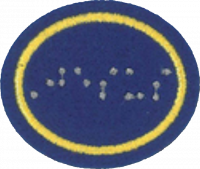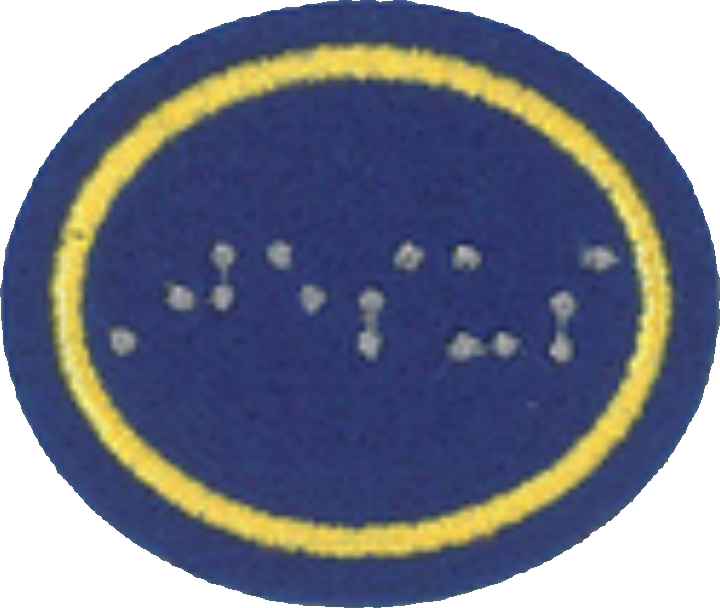Difference between revisions of "AY Honors/Braille/Requirements/en"
(Updating to match new version of source page) |
(Updating to match new version of source page) |
||
| (One intermediate revision by the same user not shown) | |||
| Line 1: | Line 1: | ||
{{HonorSubpage}} | {{HonorSubpage}} | ||
| − | |||
| − | |||
<section begin=Body /> | <section begin=Body /> | ||
| − | + | <b>1. <section begin=req1 /><noinclude></noinclude>What is a tactile reading system? | |
| − | <b>1. <section begin=req1 /><noinclude></noinclude>What is a tactile reading system? | ||
<noinclude></noinclude><section end=req1 /></b> | <noinclude></noinclude><section end=req1 /></b> | ||
| − | <b>2. <section begin=req2 /><noinclude></noinclude>Discuss who needs a tactile reading system and what is needed to read it. | + | <b>2. <section begin=req2 /><noinclude></noinclude>Discuss who needs a tactile reading system and what is needed to read it. |
<noinclude></noinclude><section end=req2 /></b> | <noinclude></noinclude><section end=req2 /></b> | ||
| − | :<b>a. <section begin=req2a /><noinclude></noinclude>Find an eye exam chart and follow the directions to test your vision. What constitutes good vision as opposed to legal blindness? | + | :<b>a. <section begin=req2a /><noinclude></noinclude>Find an eye exam chart and follow the directions to test your vision. What constitutes good vision as opposed to legal blindness? |
<noinclude></noinclude><section end=req2a /></b> | <noinclude></noinclude><section end=req2a /></b> | ||
| − | :<b>b. <section begin=req2b /><noinclude></noinclude>Using a multisensory activity, evaluate your epicritic sensitivity. | + | :<b>b. <section begin=req2b /><noinclude></noinclude>Using a multisensory activity, evaluate your epicritic sensitivity. |
<noinclude></noinclude><section end=req2b /></b> | <noinclude></noinclude><section end=req2b /></b> | ||
| − | <b>3. <section begin=req3 /><noinclude></noinclude>Briefly discuss the history of tactile reading systems, including the following points: | + | <b>3. <section begin=req3 /><noinclude></noinclude>Briefly discuss the history of tactile reading systems, including the following points: |
<noinclude></noinclude><section end=req3 /></b> | <noinclude></noinclude><section end=req3 /></b> | ||
| − | :<b>a. <section begin=req3a /><noinclude></noinclude>Who was Louis Braille? | + | :<b>a. <section begin=req3a /><noinclude></noinclude>Who was Louis Braille? |
<noinclude></noinclude><section end=req3a /></b> | <noinclude></noinclude><section end=req3a /></b> | ||
| − | :<b>b. <section begin=req3b /><noinclude></noinclude>List some of the tactile reading systems that competed with braille in “The War of the Dots.” | + | :<b>b. <section begin=req3b /><noinclude></noinclude>List some of the tactile reading systems that competed with braille in “The War of the Dots.” |
<noinclude></noinclude><section end=req3b /></b> | <noinclude></noinclude><section end=req3b /></b> | ||
| − | <b>4. <section begin=req4 /><noinclude></noinclude>Explain how braille systems are adapted to different languages. | + | <b>4. <section begin=req4 /><noinclude></noinclude>Explain how braille systems are adapted to different languages. |
<noinclude></noinclude><section end=req4 /></b> | <noinclude></noinclude><section end=req4 /></b> | ||
| − | <b>5. <section begin=req5 /><noinclude></noinclude>Demonstrate your understanding of a braille cell by writing your name in braille with a craft, LEGO, or other creative method. | + | <b>5. <section begin=req5 /><noinclude></noinclude>Demonstrate your understanding of a braille cell by writing your name in braille with a craft, LEGO, or other creative method. |
<noinclude></noinclude><section end=req5 /></b> | <noinclude></noinclude><section end=req5 /></b> | ||
| − | <b>6. <section begin=req6 /><noinclude></noinclude>Discover how braille is written. | + | <b>6. <section begin=req6 /><noinclude></noinclude>Discover how braille is written. |
<noinclude></noinclude><section end=req6 /></b> | <noinclude></noinclude><section end=req6 /></b> | ||
| − | <b>7. <section begin=req7 /><noinclude></noinclude>Discuss what materials might be the most helpful to have translated into braille and what you would want to be available in braille in the event you became blind. | + | <b>7. <section begin=req7 /><noinclude></noinclude>Discuss what materials might be the most helpful to have translated into braille and what you would want to be available in braille in the event you became blind. |
<noinclude></noinclude><section end=req7 /></b> | <noinclude></noinclude><section end=req7 /></b> | ||
| − | <b>8. <section begin=req8 /><noinclude></noinclude>Identify legal and cultural provisions in your country that make braille more accessible. | + | <b>8. <section begin=req8 /><noinclude></noinclude>Identify legal and cultural provisions in your country that make braille more accessible. |
<noinclude></noinclude><section end=req8 /></b> | <noinclude></noinclude><section end=req8 /></b> | ||
| − | <b>9. <section begin=req9 /><noinclude></noinclude>Who was Adventist pioneer Austin O. Wilson and what did he do? | + | <b>9. <section begin=req9 /><noinclude></noinclude>Who was Adventist pioneer Austin O. Wilson and what did he do? |
<noinclude></noinclude><section end=req9 /></b> | <noinclude></noinclude><section end=req9 /></b> | ||
| − | <b>10. <section begin=req10 /><noinclude></noinclude>Discuss ways to meet and interact with a person who is blind. Do one of the following: | + | <section begin=challenge /> |
| + | <b>10. <section begin=req10 /><noinclude></noinclude>Discuss ways to meet and interact with a person who is blind. Do one of the following: | ||
<noinclude></noinclude><section end=req10 /></b> | <noinclude></noinclude><section end=req10 /></b> | ||
| − | :<b>a. <section begin=req10a /><noinclude></noinclude>Visit a facility that serves people who are blind. Before the visit, ask students to write down their predictions about their perceptions of blind people. Collect and keep responses to review after the visit. | + | :<b>a. <section begin=req10a /><noinclude></noinclude>Visit a facility that serves people who are blind. Before the visit, ask students to write down their predictions about their perceptions of blind people. Collect and keep responses to review after the visit. |
<noinclude></noinclude><section end=req10a /></b> | <noinclude></noinclude><section end=req10a /></b> | ||
| − | :<b>b. <section begin=req10b /><noinclude></noinclude>Invite a blind person to speak to your group about his/her experiences. Before the visit, ask students to write down their predictions about their perceptions of blind people. Collect and keep responses to review after the visit. | + | :<b>b. <section begin=req10b /><noinclude></noinclude>Invite a blind person to speak to your group about his/her experiences. Before the visit, ask students to write down their predictions about their perceptions of blind people. Collect and keep responses to review after the visit. |
<noinclude></noinclude><section end=req10b /></b> | <noinclude></noinclude><section end=req10b /></b> | ||
| + | <section end=challenge /> | ||
<section end=Body /> | <section end=Body /> | ||
| − | |||
| − | |||
| − | |||
| − | |||
| − | |||
Latest revision as of 20:20, 20 July 2022
1. What is a tactile reading system?
2. Discuss who needs a tactile reading system and what is needed to read it.
- a. Find an eye exam chart and follow the directions to test your vision. What constitutes good vision as opposed to legal blindness?
- b. Using a multisensory activity, evaluate your epicritic sensitivity.
3. Briefly discuss the history of tactile reading systems, including the following points:
- a. Who was Louis Braille?
- b. List some of the tactile reading systems that competed with braille in “The War of the Dots.”
4. Explain how braille systems are adapted to different languages.
5. Demonstrate your understanding of a braille cell by writing your name in braille with a craft, LEGO, or other creative method.
6. Discover how braille is written.
7. Discuss what materials might be the most helpful to have translated into braille and what you would want to be available in braille in the event you became blind.
8. Identify legal and cultural provisions in your country that make braille more accessible.
9. Who was Adventist pioneer Austin O. Wilson and what did he do?
10. Discuss ways to meet and interact with a person who is blind. Do one of the following:
- a. Visit a facility that serves people who are blind. Before the visit, ask students to write down their predictions about their perceptions of blind people. Collect and keep responses to review after the visit.
- b. Invite a blind person to speak to your group about his/her experiences. Before the visit, ask students to write down their predictions about their perceptions of blind people. Collect and keep responses to review after the visit.


